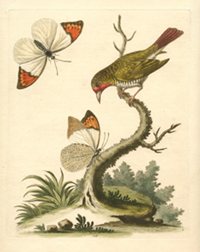 Almost naïve and arrestingly charming are the distinctive illustrations of birds and animals by the ‘father of British ornithology’ George Edwards (1694-1773), who included butterflies with some of his “uncommon birds” published in London between 1743 and 1751. The Copley gold medal was usually awarded by the Royal Society in recognition of great scientific discoveries, but in 1750 it was awarded to George Edwards “on account of the great pains he has been taking for many years to improve our knowledge of birds and other animals… a very curious Book… containing figures elegantly drawn and illuminated in their proper colours”.
Almost naïve and arrestingly charming are the distinctive illustrations of birds and animals by the ‘father of British ornithology’ George Edwards (1694-1773), who included butterflies with some of his “uncommon birds” published in London between 1743 and 1751. The Copley gold medal was usually awarded by the Royal Society in recognition of great scientific discoveries, but in 1750 it was awarded to George Edwards “on account of the great pains he has been taking for many years to improve our knowledge of birds and other animals… a very curious Book… containing figures elegantly drawn and illuminated in their proper colours”.
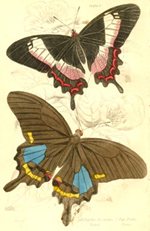
A century later the steel engravings by William Home Lizars (1788-1859) demonstrated more realism. Each small engraved nature portrait was beautifully hand-coloured, and accentuated by leaving the background habitat uncoloured. After being apprenticed to his father, Daniel Lizars, at his Edinburgh engraving and publishing business, William studied at the Trustees’ Academy from 1804 to 1808. His portraits and genre gained him fame when they were exhibited at the Academy, but after Daniel Lizars died William assumed responsibility for his business and concentrated on engraving and publishing.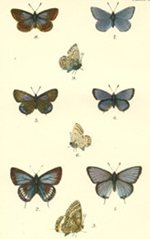
W.H. Lizars' skill as an engraver was recognized when he was elected an Associate Engraver of the Royal Scottish Academy in 1827. Between 1833 and 1866 Lizars engraved 1,248 species of fauna and published 40 small octavo-size volumes of Jardine’s Naturalist’s Library for eminent Scottish naturalist, Sir William Jardine (1800-1847). Jardine’s main passion was ornithology - and William’s sister, Jane Home Lizars, whom he married. Sixty years after their initial publication, Edward Lloyd reissued Jardine’s enormous work and Wyman & Sons used the steel-engraved plates by Lizars to colour-print lithographs of nature, including butterflies.
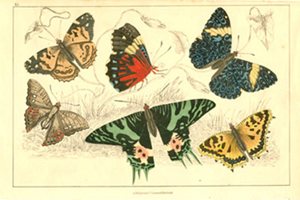 Another interesting fellow was Irish novelist and playwright, Oliver Goldsmith (1730?-1774), who began translating Pliny the Elder’s Natural History, on all scientific matter from ancient times - and then published his own A History of the Earth and Animated Nature by Oliver Goldsmith, which included the latest knowledge of the universe, nature and mankind. In the first edition of 1774 the small full-page illustrations were crammed with tiny figures representing different subjects. Over the next 80 years 20 different editions were published with ‘corrections and alterations’. Publications were still attributed to Oliver Goldsmith, with eminent natural scientists contributing. ‘Beautiful and appropriate’ hand-coloured engravings of fauna were commissioned, which ensured the continuing popularity of the work. The hand-coloured illustrations of the 1848 edition were among the finest.
Another interesting fellow was Irish novelist and playwright, Oliver Goldsmith (1730?-1774), who began translating Pliny the Elder’s Natural History, on all scientific matter from ancient times - and then published his own A History of the Earth and Animated Nature by Oliver Goldsmith, which included the latest knowledge of the universe, nature and mankind. In the first edition of 1774 the small full-page illustrations were crammed with tiny figures representing different subjects. Over the next 80 years 20 different editions were published with ‘corrections and alterations’. Publications were still attributed to Oliver Goldsmith, with eminent natural scientists contributing. ‘Beautiful and appropriate’ hand-coloured engravings of fauna were commissioned, which ensured the continuing popularity of the work. The hand-coloured illustrations of the 1848 edition were among the finest.
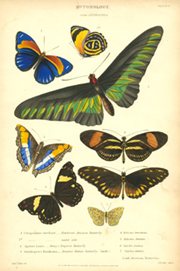 William Mackenzie’s The Museum of Natural History was another publication that remained popular for over 70 years. In 1860 it included brightly-coloured steel engravings of butterflies by Joseph Wilson Lowry, after drawings by Nathaniel J. Holms. Trained by his engraver father, Wilson Lowry, Joseph inherited his parents’ love of science. J.W. Lowry was better known for his encyclopaedia engravings, geological surveys, naval architecture and other more mechanical subjects, but he exhibited a light hand in his engravings of nature subjects.
William Mackenzie’s The Museum of Natural History was another publication that remained popular for over 70 years. In 1860 it included brightly-coloured steel engravings of butterflies by Joseph Wilson Lowry, after drawings by Nathaniel J. Holms. Trained by his engraver father, Wilson Lowry, Joseph inherited his parents’ love of science. J.W. Lowry was better known for his encyclopaedia engravings, geological surveys, naval architecture and other more mechanical subjects, but he exhibited a light hand in his engravings of nature subjects.
Although her finest hand-coloured engravings are rarely seen today, German-born Maria Sibylla Merian (1647-1711) left Amsterdam for Suriname (Dutch Guiana) where she collected and painted butterflies and their host plants with her daughter, Dorothea Maria. Contradicting previous misconceptions about a butterfly’s lifecyle her Metamorphosis Insectorum Surinamensium (Life Stages of Surinam Insects) was published between 1705 and 1719. Her work was praised by the scientific community and she is credited with being the first female entomologist.
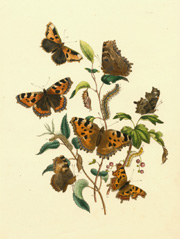
The format of her illustrations of butterflies with their caterpillars and chrysalises on the foliage of their host plants was repeated 150 years later in the hand-coloured lithographs of butterfly transformations by Henry Noel Humphreys (1810-1879), - adding another delightful dimension to the illustration of butterflies. Humphreys wrote,
The study of natural history is the learning of the characters with which the wonderful story of nature is written... I cannot conceive a more pleasing and natural introduction to its general study than entomology, of which I think the division of Lepidoptera... the most easy and attractive section.” (Lepidoptera includes butterflies and moths.)
Fine quality natural history illustrations have always been revered. Unlike some species of nature, despite their fragility butterflies seem to have retained a consistency of characteristics over the centuries. The final metamorphosis of a butterfly is aptly known by the term imago – image of its ancestors. Whether you have a hankering to study them or not, framed antique prints of butterflies on your wall certainly add grace and charm to any room. Here on our antiqueprintclub.com website you will find a lovely selection of antique prints of butterflies.